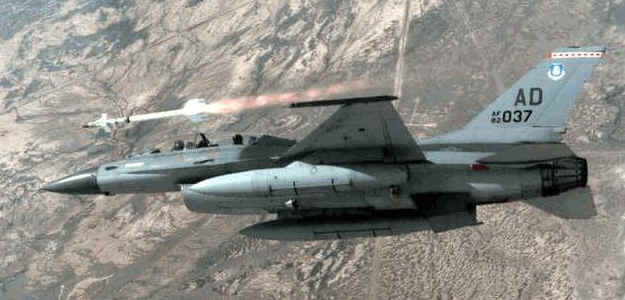The AGM-122 Sidearm can be carried by the US Army AH-64D Apache and Marine Corps AH-1Z SuperCobra attack helicopters for self-defense against anti-aircraft guns and SAM radars. The Sidearm is a rebuilt AIM-9C air-to-air missile (below), in which the narrow band semi-active seeker electronics have been modified for the much greater bandwidth required to home-in on a wide range of radars.

Sidearms were developed over a decade ago, yet are not used by attack aircraft to suppress enemy air defenses during bombing runs. What if some were mounted rear-facing and fired when their radar warning receiver detects a bogey getting ready to fire from behind, or at air defense radars as the aircraft pulls away after an attack run? They can be set on automatic fire for attack runs, so if a Sidearm detects a radar transmission it fires instantly. They may be able to down radar-emitting fighters head on, or even shoot down self-guided radar-equipped missiles like the AIM-120 AMRAAM.
In 2004, it was revealed by Aviation Week (7-26-04) that the Russians fielded such a missile over a decade ago. The R-27 air-to-air missile, a version of the AA-10 Alamo, is fitted with a passive radar seeker that can detect aircraft radar 75 miles away. The Russians realized that the targeted radar will see the incoming missile and probably shut down for evasion. However, shutting down radar during the critical engagement period is problematic, especially if that radar is guiding a long-range air-to-air missiles. The article noted this missile has been exported to China and India.
Sidearms can also be used in an anti-ship role to home-in on the powerful radar systems used by ships. Sidearms can be fired from the ground using platforms like the retired Chaparral surface-to-air missile system, which was designed to fire Sidewinder missiles. This allows ground forces to destroy radar-emitting surface-to-air missile systems and counterbattery radar. A proximity fuze will ensure that it explodes when it might otherwise fly past an antenna. The missile may be programmed to fly six feet lower than its sensor indicates to hit the radar site rather than just the antenna, and to hopefully catch "ducking giraffe" radar systems. Future versions may have a dual seeker, which includes an infrared seeker that takes control should the radar signal be lost. This may allow it to destroy vehicle mounted radar systems that shut down at the last moment and drive onward.
Another mystery is why missiles like Sidearm are not tweaked to seek radio frequencies, like those produced by headquarters and vehicles for communications. In high-threat environments, an aircraft may see a concentration of enemy vehicles or cluster of tents from high-altitude. The pilot can fire a modified Sidearm in that direction from ten miles away to pick-up on radio transmissions and home-in for the kill. At Mach 2, this 185 lb missile will knock out any heavy tank. As attack helicopters approach numerous enemy vehicles, they may fire Sidearms first knowing that their arrival will cause a spike in radio and radar activity. The impact of Sidearms will cause chaos just before helicopters come within range to employ their main weaponry. The Sidearm is a revolutionary weapon whose value remains undiscovered.
©2015 www.G2mil.com